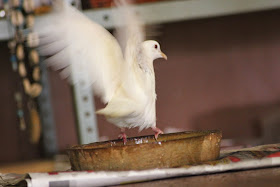Camera : Canon EOS 550D
This is Little White Dove, a White Ringneck Dove I found in my garden last June 2013, minus a tail and a big wound on her coccyx. After coaxing her down from the tree with some seeds, I managed to capture her and tend to the wound. She had obviously escaped from a cage or aviary somewhere in the area and must have been somebody's pet as she did not seem overly concerted about being picked up.
The wound healed nicely and within a few days the first new feathers appeared. A week later, a nice little tail had started forming (below).
Little White Dove sporting a brand-new tail
I offered her a bowl with water and within minutes she had her first bath in the two weeks she'd been with me.
Wow! That was great!
Tweeti, my 16-year old Cockatiel, has taken quite a liking to Little White Dove and he will spend every minute he can get with her, singing to her and giving her tail gentle little plucks. Little White Dove is not worried or perturbed by these proceedings and just seems to take it in her stride.
These birds have been bred in cages since biblical times as pets and cannot survive in the wild. They often are not able to find food having had it provided to them all their life and because of their white colour they are easy prey for a variety of predators. Thus many of these released birds, usually at weddings or parties, die or are killed in a relatively short time. Many white doves that have been released end up looking to humans for assistance.
Little White Dove has also become quite tame, loving to come out of her cage and wandering around my studio. She will also come when I call her for some bread or chopped peanuts and intently watches me when I chop her vegetables and fill her bowl. We’re not yet at the stage where she will sit on my shoulder, but we’re getting there!
The white dove is a colour mutation of the African collared dove/Barbareydove that has been around for perhaps a thousand years. A number of species of collared doves are native to Africa and Asia.
.




















Maree, I am sure I have said this before, but you are a saint!
ReplyDeleteKathryn xx
Big smile! Thanks Kathryn, but not so much a saint as the fact that they all seem to seek me out and I have no say over the matter! Little White Dove has grown into an utterly loving little bird and often coo's to let me know she wants to come out.
DeleteI was just researching my own dove when I came across this. I just wanted to say that I had the same experience with find doves as you did! My Tinker looks just like your Little White Dove (though all white doves look pretty much the same). I actually found two doves and you should have seen how happy Gypsy was when we first gave him a bird bath! He was so dirty for weeks before we realized what he wanted. When I found Gypsy he was missing a lot of feathers from his wings. How is your bird doing? Does she like riding on your shoulders yet? Tinker loves flirting and sitting on my shoulders. Reading the things you have written here, I think you are a woman after my own heart!
ReplyDeleteHi Claire, so nice to hear of somebody that also knows about White Doves! they are amazing little birds, soooo loving and sooo intelligent! My little Dove also loves her daily bath and she's doing fine, even coming when I call her. And thanks for all your kind remarks, hope you have a great day!
Delete